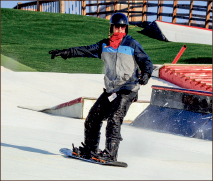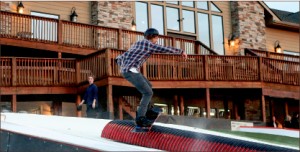Snowflex gains popularity

The Sochi Olympics has brought attention to athletes training on artificial snow
Liberty ski and snowboard Head Coach Ryan Leeds said he believes the artificially engineered slopes of the Snowflex has a broad appeal among riders, and the use of it to train Olympic-level-athletes is only increasing interest.

RAILS — The Snowflex offers skiing and snowboarding lessons year-round. Photo credit: Courtney Russo
Although the Liberty Mountain Snowflex Centre is the first slope of its kind in North America, several Olympic athletes have come to use its slopes such as James “Woodsy” Woods, Katie Summerhayes and Jamie Nicholls of the Great Britain Team, according to the Snowflex website.
“I think Snowflex attracts people mainly because it’s different,” Leeds said. “Ours here is a very freestyle oriented Snowflex facility. So that definitely attracts the (type of) crowd that we get.”
Despite the appeal of the Snowflex, Leeds feels most people are drawn to it out of convenience rather than attraction.
“Snow is what we would prefer to be on, as it’s a better substance,” Leeds said. “But Snowflex isn’t a bad alternative. It’s the closest that we’ll get. We appreciate it, we like being able to snowboard and ski year round.”
Freshman Brendan McHugh from the Liberty snowboarding team said he appreciates the yearlong availability of the Snowflex, as it has given him much more time to practice.
“Snowflex is great, because I can go every day,” McHugh said. “When I’m done with classes, I can just go up there and get away from everything. With snow, I didn’t get to go that often. I could go two times a week during the winter when I was back home (in Pennsylvania). ‘Cause it’s just a long ways away, 35 minutes to an hour, and I couldn’t do that every day.”
In addition to its availability, Leeds also said Snowflex allows users to further develop their skills in ways that would be more difficult on a regular slope.
“The advantage to the Snowflex over snow as far as training goes is just the fact that Snowflex doesn’t hurt as much when you fall, because its got foam padding underneath all of it,” Leeds said. “So it allows you to progress in your tricks and try new tricks, and when you fall, because it doesn’t hurt as much, you can continue to try it until you perfect it.”
According to Leeds, the Snowflex offers better conditions for speed training than snow resorts offer.
“Because our Snowflex run is so short, they get to take so many more laps than a person would on a normal mountain,” Leeds said. “The next best thing would probably be consistency. On a normal resort, on snow, features are always changing and inconsistent. It can be very hot that day, so snow could turn to slush, which changes the speed. With Snowflex, it never changes. It’s always the same.”
McHugh feels the consistent nature of the Snowflex and his ability to build his muscle memory has helped him greatly improve over the past year.
“The level I was riding before I came here to what it is now has just improved so much,” McHugh said. “And that is a lot because I can go every day, and it’s also because the coaches up there know exactly what they are doing and how to help you learn new tricks and just do everything right and keep progressing.”
In regards to the Olympics, Leeds said the Snowflex is a good place to get the basics of the sport down before advancing to more difficult slopes.
“We definitely have the advantage of being able to instill in (the snowboarding team) muscle memory,” Leeds said. “A lot of people that are on the Britain team that came from Snowflex, the reason they were able to progress so well is that they were able to get the fundamentals down on Snowflex, and once they got the recognition, they were able to get coaches and sponsors that were able to provide the money for them to go and train on bigger mountains with bigger features and bigger resorts.”
Despite the benefits, Leeds said overreliance on the comforts of the Snowflex can cause difficulties for some riders when they shift to actual snow slopes.
“The only thing we have a disadvantage of is that, since we train on Snowflex so much, we don’t get on snow until the (winter) season,” Leeds said. “And so a lot of times, people have trouble taking their Snowflex tricks to snow, because there is a mental barrier. They know that when they fall on snow, it’s going to hurt way more. So when you take a fall doing a trick you can normally do on the Snowflex, there is a greater level of risk involved.”
According to Leeds, the Snowflex gives the Liberty snowboarding team the biggest advantage over every school they compete with on the Southeast.
“Our record really speaks for itself,” Leeds said. “We usually win all of our competitions in the South East.”
For more information on the Snowflex, visit liberty.edu/snowflex.

